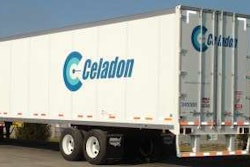Model of efficiency?

Boil down more than 1,000 pages of regulation and analysis on the proposed heavy truck fuel efficiency and greenhouse gas reduction standards and you are left with this conclusion: Either you are clueless or the government is misleading the American people.
OK, that’s too easy. But the point is the proposed rule presumes that you need to be forced to save fuel. The proposal relies on existing technologies that you could spec today; it doesn’t require that truck manufacturers adopt cutting-edge systems and devices not already on the market. In other words, if these technologies – items such as aerodynamic styling and appliances, single wide and low rolling resistance tires, aluminum wheels, speed limiters and so on – cut your fuel costs and made sense operationally, wouldn’t you already use them? Of course. So do the Environmental Protection Agency and the National Highway Traffic Safety Administration really need a regulation that forces you to do what is in your financial best interest?
The short answer is yes because Congress basically mandated heavy truck fuel efficiency rules nearly three years ago. And if you must regulate, a rule that relies on existing commercial available technologies certainly is preferable to one that pushes the envelope too aggressively. The trucking industry has been down that road before, perhaps most notably with braking standards in the 1970s.
So the issue isn’t really that the EPA/NHTSA proposal is a bad regulation. The agencies have tried to accommodate differing duty cycles, although they probably should do more. Rather, the real flaw in the regulation is the notion that it accomplishes all that much.
Surges in diesel prices have most truck owners looking for fuel-saving solutions. Indeed, one reason adoption of fuel-saving technologies on new trucks hasn’t been more rapid is that so few trucks have been sold in the last three years – a situation exacerbated by EPA regulations.
Truck productivity is where true progress lies.
Once freight returns solidly, you can bet that the specifications EPA and NHTSA would like to see will be popular. For example, many truck owners will adopt weight-saving specs – often to offset weight gains resulting from EPA’s latest standards on emissions of oxides of nitrogen. Also, the California Air Resources Board already mandates several fuel-savings technologies on many new long-haul tractors operating in the state. At least that is true as of today. By the time you read this, the voters of California will have decided whether or not to suspend the state’s greenhouse gas reduction rules until the state’s unemployment rate drops to 5.5 percent or less for a full year.
The EPA/NHTSA regulation could push truck makers to encourage their customers to make the leap to technologies that they had not already adopted, but that transition is inevitable anyway and likely will have occurred even before the rules take effect. Where the rule might have some real effect is in limiting the opportunity of some buyers to spec trucks they shouldn’t be spec’ing anyway – the long-haul trucker who wants the longest, squarest hood he can find, for example. That might be frustrating to the buyer, but it’s not the end of the world.
Perhaps the most groundbreaking aspect of the EPA/NHTSA rule is its implicit recognition of the value of truck productivity. By adopting gallons of fuel per 1,000 ton-miles as the key fuel consumption metric, the agencies are proposing to regulate fuel efficiency, not fuel economy. The greater the gross vehicle weight rating, the greater the efficiency – all other things being equal. The trucking industry has been divided on the issue of truck size and weight, but one big step came last month when the Truckload Carriers Association endorsed an increase in the federal maximum weight to 88,000 pounds.
Hauling more freight with fewer trucks is where we will make great strides. These regulations won’t revolutionize the industry, but that’s OK. The main goal should be to make sure they do no harm.
Avery vise is Editorial Director of Commercial Carrier Journal.
E-mail [email protected].











